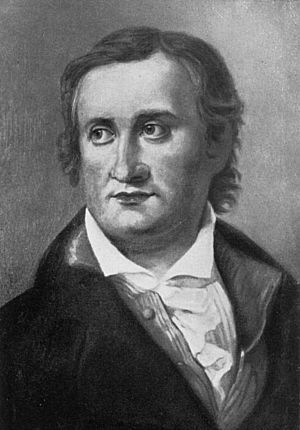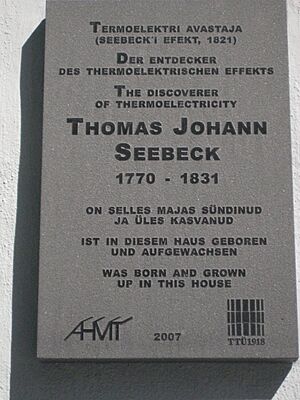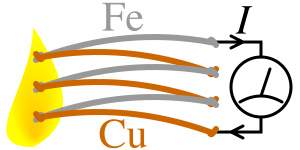Thomas Johann Seebeck facts for kids
Quick facts for kids
Thomas Johann Seebeck
|
|
|---|---|
 |
|
| Born | 9 April 1770 |
| Died | December 10, 1831 (aged 61) |
| Known for | Discovering the thermoelectric effect |
| Scientific career | |
| Fields | Physics |
Thomas Johann Seebeck (born April 9, 1770 – died December 10, 1831) was a Baltic German physicist. In 1822, he noticed a special connection between heat and magnetism. A year later, in 1823, another scientist named Ørsted called this discovery the thermoelectric effect.
Seebeck was born in Reval, which is now called Tallinn in Estonia. His family was wealthy and involved in trade. Even though he earned a medical degree in 1802 from the University of Göttingen, he really loved studying physics more than medicine.
From 1821 to 1823, Seebeck did many experiments. He wanted to understand what Ørsted had found in 1820 about electricity and magnetism. During his experiments, Seebeck saw that if you connect two different metals and heat one end, a compass needle nearby would move.
Because Ørsted had shown that electric current makes a compass move, Seebeck's discovery was seen as a "thermoelectric effect." This effect is now known as the Peltier–Seebeck effect. It is super important and is used in things like thermocouples and thermopiles, which help measure temperature.
Contents
Understanding the Seebeck Effect
In 1822, Thomas Johann Seebeck made an important discovery. He found that if you make a loop with two different kinds of metals and heat one connection point while keeping the other cool, a compass magnet nearby will move.
Seebeck first thought this movement was caused by magnetism created by the temperature difference. He even made a chart showing how different metal pairs would make the compass move. He believed his findings showed how metals and volcanoes might affect Earth's magnetism.
At that time, scientists had different ideas about how electricity and magnetism were connected. Some, like Ørsted and Seebeck, believed in a "polarity of Nature." They thought all forces, like electricity, magnetism, heat, and light, were related. Others, like André-Marie Ampère, followed Isaac Newton's ideas about forces. Ørsted saw Seebeck's experiment as proof that electricity, magnetism, and heat were indeed linked.
Later, after the electron was discovered, scientists understood the Seebeck effect better. They realized that the temperature difference actually creates an electric current. This current then makes the compass needle move, just as Ampere's law explains.
Simply put, when there's a temperature difference, it creates an electric potential, or voltage. This voltage can then push an electric current through a closed loop of wires. Today, we call this the Peltier–Seebeck effect.
The amount of voltage produced is directly related to how big the temperature difference is between the two connection points. This relationship is described by something called the Seebeck coefficient. This effect is the main idea behind a thermocouple, which is a device often used to measure temperature very accurately.
The voltage or current happens because electrons move from areas where there are many electrons to areas where there are fewer. Different metals have different numbers of electrons, so when they are heated unevenly, electrons start to spread out.
If both connection points are at the same temperature, electrons move equally in both directions, so there's no net current. But if the temperatures are different, more electrons move in one direction, creating a net current. This whole process is known as thermoelectricity.
Early Work on Color Photography
In 1810, Seebeck also studied how light affects silver chloride. He noticed that this chemical would sometimes take on a faint version of the color of the light it was exposed to. He also reported that light beyond the violet part of the spectrum had an effect. Seebeck even worked with the famous writer and scientist Goethe on his "Theory of Colours."
Other Discoveries
Thomas Seebeck made several other important contributions:
- In 1808, he was the first to create and describe the amalgam of potassium. An amalgam is a mixture of mercury with another metal.
- In 1810, he observed the magnetic properties of two metals: nickel and cobalt.
- In 1818, Seebeck discovered that sugar solutions have optical activity. This means they can rotate polarized light.
|
See also
 In Spanish: Thomas Johann Seebeck para niños
In Spanish: Thomas Johann Seebeck para niños



